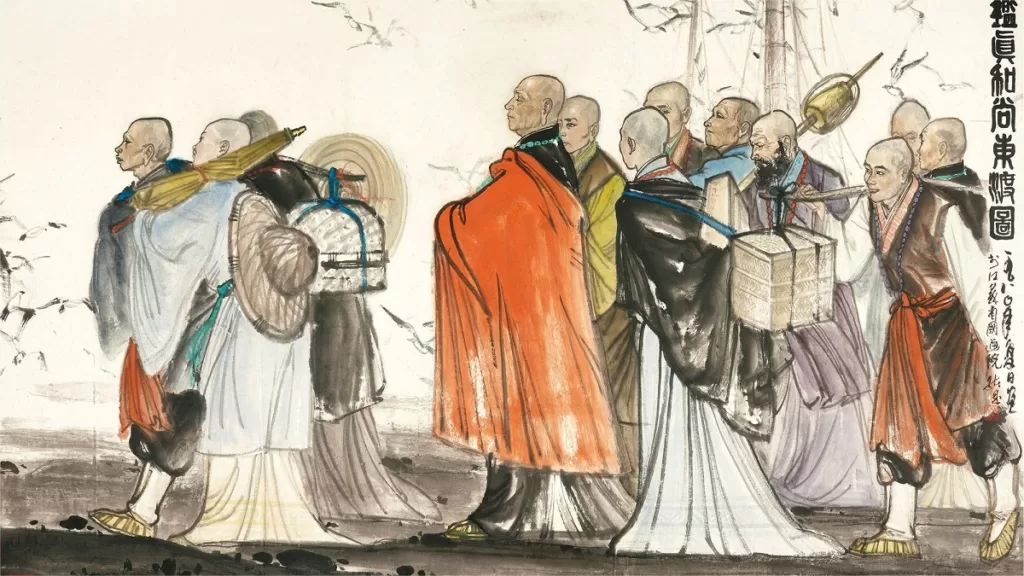Monk Master Jianzhen – A Prominent Figure in Chinese and Japanese Buddism


Monk Master Jianzhen (鉴真), also known as “Kanzeon” in Japanese, was a renowned Buddhist monk during the Tang Dynasty and is revered as the founding patriarch of the Ritsu (律宗) school of Buddhism in Japan. He is often referred to as the “Great Teacher Who Crossed the Sea” and the “Great Monk of the Tang Dynasty.” Born with the surname Chunyu, he hailed from the city of Guangling Jiangyang, now part of modern-day Yangzhou in Jiangsu Province, China. From a young age, Jianzhen devoted himself to a life of religious practice, embarking on a journey of exploration and study of Buddhist scriptures in various places, including Luoyang and Chang’an.
Jianzhen’s significance and influence on both Chinese and Japanese Buddhism are deeply rooted in his tireless efforts to propagate the Vinaya, a code of monastic discipline in Buddhism. His commitment to spreading the Dharma and his expertise in the Vinaya led him to return to the Great Ming Monastery in Yangzhou, where he began teaching and transmitting the Buddhist precepts and laws.
In the year 742, during the reign of Emperor Xuanzong of the Tang Dynasty, Jianzhen received an invitation from two Japanese monks, Eon and Fusho, to travel to Japan to assist in revitalizing the practice of Buddhist monastic discipline. Determined to fulfill this mission, Jianzhen embarked on a series of perilous attempts to cross the sea to Japan. However, he faced repeated obstacles, including official restrictions and dangerous sea voyages due to storms. Tragically, he lost his eyesight during these tumultuous journeys, and Eon passed away while waiting for his arrival.
In the year 754, after several failed attempts, Jianzhen finally succeeded in crossing the sea to Japan, accompanied by other monks and disciples, including Bhikkhu Hōnin, Bhikkhuni Shōshi, and Upāsaka Ban Dō. They landed in Akune, Kagoshima, on the southern coast of Kyushu. Soon after, Jianzhen was warmly welcomed in Japan, particularly by Emperor Shōmu, Empress Kōmyō, and Crown Prince Shōtoku. He played a pivotal role in establishing the Ritsu school in Japan by conferring the Bodhisattva precepts and Vinaya on the Japanese clergy, including more than 440 novice monks and nuns, and by renewing the precepts of over 80 existing monastic institutions.
Jianzhen’s arrival in Japan marked the formal transmission of Buddhist monastic discipline and the establishment of the Ritsu school in the country, solidifying his position as the founding patriarch of the Japanese Ritsu tradition.
Besides his religious contributions, Jianzhen’s influence extended to the realm of art and architecture. He and his disciples brought advanced Tang Dynasty craftsmanship and artistic techniques to Japan. Notable examples of their work include the construction of the Tōshōdai-ji temple complex, which remains one of the most significant architectural achievements of the Japanese Nara period. This temple showcases the distinctive features of Tang Dynasty architecture and artwork, leaving a lasting impact on Japanese art history.
Jianzhen’s dedication to Buddhism and his profound impact on Japanese culture extended to various other areas as well. His proficiency in calligraphy, combined with his influence, contributed to the enduring popularity of Chinese calligraphy in Japan. Moreover, Jianzhen made significant contributions to Japanese medicine and is considered the founding figure of medical knowledge in Japan. He is credited with transmitting various technical skills, including those related to tofu production, dietary practices, and brewing techniques, which have had a lasting impact on Japanese cuisine and industry.
Monk Master Jianzhen’s life and legacy exemplify his unwavering commitment to Buddhism, his dedication to the propagation of monastic discipline, and his profound influence on the cultural and religious development of both China and Japan. His teachings, contributions, and cultural exchanges continue to be celebrated and remembered by people in both countries to this day.